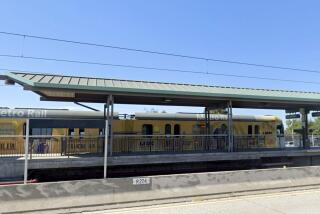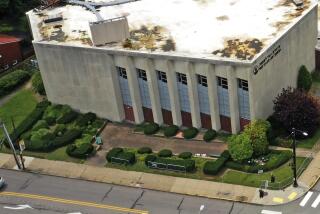Historic Structure Razed 25 Years Ago : Defunct Penn Station a Preservationist Rallying Point
- Share via
NEW YORK — It was a monument to the glory of the Roman Empire and the Pennsylvania Railroad, a great temple of marble and granite married to a soaring tent of steel and glass. Here was a building, wrote Thomas Wolfe, “vast enough to hold the sound of time.”
Built to last for centuries, Pennsylvania Station was only 53 years old when jackhammers began pounding its walls on Oct. 28, 1963, to make way for a drum-shaped sports arena and a bland, glass-and-steel office building.
Except for a few protesters who circled disconsolately in a drizzle, the station passed unmourned.
The demolition crew foreman said it was just another job. “If anybody seriously considered it art, they would have put up some money to save it,” his boss added.
“This city’s got the right name--New York,” observed a man behind the counter of the station restaurant. “Nothing ever gets old around here.”
Over the next two years Penn Station was broken into pieces, dumped in a New Jersey swamp and replaced by the subterranean station that bears its name today.
The only reminder of the landmark that filled two blocks on Seventh Avenue between 31st and 33rd streets are two eagles that once perched on a ledge over the front door, but now squat on the ground.
Legacy of Preservation
But the old station has monuments wherever people have fought to save the buildings they love, because the fall of Penn Station marked the rise of the preservation movement in New York and around the nation.
“Most preservation groups form around a preservation battle, and often they lose the first one,” said Sally Oldham of the National Trust for Historic Preservation. “The whole story of the movement is the story of lost buildings.”
Pennsylvania Station was the greatest loss of all.
“Through it one entered the city like a god,” architectural historian Vincent Scully has written. “One scuttles in now like a rat.”
At the turn of the century the Pennsylvania Railroad was the largest company in the greatest industry the world had ever known. The railroad’s president, Alexander Cassatt, wanted a building that would make a trip into the city an occasion.
Inspired by the Baths of Carcalla in Rome, architect Charles Follen McKim designed a station twice as large as the Hamburg railroad station, then the world’s largest, and nearly three times larger than any American station.
McKim’s vision was set on the edge of Hell’s Kitchen, a rough West Side neighborhood of factories, stockyards, slaughterhouses and tenements. Five hundred buildings were razed to make way for the station, and 1,500 people displaced.
When work began in 1906, people compared the excavation to the Panama Canal. “The great hole,” as it was known, reached 58 feet into the ground.
When it was finished in 1910, observers were equally impressed. On Seventh Avenue, a two-block-long row of Doric columns--each 35 feet high and 4 feet thick--rose to meet a low roof.
Granite Eagles
Fourteen granite eagles, each 5 feet tall and 5,700 pounds, roosted on a ledge under the roof. Each of the four main entrances was topped by a clock with a dial 7 feet in diameter, flanked by the statues of women symbolizing night and day.
But the new station’s real attractions were inside. The general waiting room, the size of the nave of St. Peter’s, featured six-story high Corinthian columns and a vaulted ceiling 150 feet high. Through it passengers moved to the train shed, whose soaring glass-and-steel roof achieved the same effect as the waiting room, only on modern terms.
William Faulkner heard in the rafters “the voices of all the travelers who have ever passed through.” They ranged from President Franklin D. Roosevelt, heading for his home in Hyde Park, to the Depression homeless, going nowhere.
In those days it did not matter that the station was architecturally unrelated to anything around it, or that its huge spaces, exhilarating on first sight, became tiresome when crossed repeatedly. So what if there were no seats in the main waiting room, or an information booth?
But the end of World War II was the beginning of hard times for railroads. By 1951 the Pennsylvania Railroad was running a $72-million annual deficit. Four years later, the railroad quietly agreed to sell the station’s surface space to developers and build a new, smaller station below street level.
Meanwhile, the Pennsy’s deteriorating finances were reflected in its station. The train shed’s glass roof became grimy with soot, and broken windows were replaced with metal. The huge topographic wall maps that depicted the railroad’s territory were almost obliterated. The pink granite had turned a dull city gray.
The general waiting room was marred by a modern structure that housed ticket booths, as well as incongruous advertising signs and displays that critic Lewis Mumford said turned the room into “a vast jukebox.”
Finally, in 1961, the railroad broke the news: Penn Station would come down to make way for the third Madison Square Garden.
‘Solid Gold’
Critic Ada Louise Huxtable noted that Americans could never again afford to build a nine-acre structure of superbly detailed solid travertine, “any more than we could build one of solid gold,” and a few young architects organized in protest and picketed the station.
The outcome was never in doubt. The public had no interest in saving the dirty, neglected old building, and the city had no authority.
But that began to change almost as soon as the station’s destruction began. The next day the New York Times called it “the shame of New York” and concluded: “We want and deserve tin-can architecture in a tin-horn culture. And we probably will be judged not by the monuments we build but by those we have destroyed.”
In death, the station became more precious than in life. As it slowly was demolished over the next two years, people had time to contemplate the twisted steel and broken marble to which the station had been reduced. The railroad was deluged with requests for the station’s remains, ranging from the eagles to squares from the floor.
“Suddenly the preservation issue was on the front page across the country, and it created the feeling of ‘we are not alone’ among local preservation groups,” said Elliott Willensky, an architect who protested the station’s destruction.
Penn Station’s destruction touched a nerve because it was the most visible sign of what had been going on across the nation for the previous 15 years.
Between 1930 and 1946, Depression and war curtailed construction of new buildings and thus the destruction of old ones. But in the boom that followed the end of World War II, virtually no historic building was safe.
In South Philadelphia, hundreds of late 18th- and early 19th-Century buildings were destroyed to make way for an interstate highway. In Bridgeport, Conn., an 1848 Gothic revival mansion that had been willed to the city was torn down to make way for a parking lot. Boston lost its Opera House in 1957, and a group of buildings designed by Bullfinch on India Wharf five years later.
Turning Point
But Penn Station’s loss seemed to mark a turning point. “Its death was necessary to make us realize what could be lost,” journalist Lorraine Diehl later mused.
Largely in response, New York City created the Landmarks Preservation Commission. Although a few cities, notably Charleston, S.C., and New Orleans, already had such agencies, New York’s could designate entire neighborhoods as historic districts.
Although the commission cannot grant a building absolute protection--there are circumstances under which an owner can tear a landmark down--the new law made their destruction far more difficult.
To date, the commission has landmarked 824 individual structures, 75 interiors and 9 parks, plus 14,415 buildings in 50 historic districts including the upper East Side, Greenwich Village and Brooklyn Heights. Flatbush alone has three separate districts.
Without commission protection, many architectural jewels--notably the Radio City Music Hall--almost certainly would have been destroyed or significantly altered.
Federal highway and urban renewal funds had been used to destroy thousands of historic buildings, but in 1966 the National Register of Historic Places was created to hamper such destruction.
Before the National Register, the federal government recognized only about 900 landmarks, and afforded them no protection. Today, the register has more than 50,000 entries, including whole neighborhoods like Washington’s Georgetown.
At the local level, where buildings are saved or lost, more than 1,000 communities have preservation zoning ordinances, compared to fewer than 40 in 1963.
Many Saved
In the years since Penn Station’s demise, many great buildings have been saved: the Wainwright Building in St. Louis, an early skyscraper designed by Louis Sullivan; Grand Central Terminal in New York, whose protection by the Landmarks Commission was upheld by the Supreme Court; the ornate old Executive Office Building, next door to the White House, which was saved when Congress refused to appropriate funds for its demolition.
Today, preservationists remember Penn Station the way Texans remember the Alamo. When some of them wanted to protest a proposed change in the city landmarks law earlier this year, they returned to the scene of the crime.
“The lesson we learned here is that if we fail to be vigilant, we will lose the things that matter,” one speaker said.
The lesson is about all that’s left of the old station. For a time train passengers riding to and from New York through the New Jersey Meadowlands could see the remains, including the sculpted female figures of day and night.
A few pieces were claimed by the Brooklyn Museum and Ringwood Manor State Park in New Jersey. Some of the eagles were shipped to the Pennsy’s 30th Street Station in Philadelphia, as well as to stations along the Long Island Rail Road.
The station’s destruction could not save the Pennsylvania Railroad, which merged with the New York Central in 1968 and filed for bankruptcy two years later, leaving railroading to the federal government.
The “new” Penn Station--which needed a massive renovation less than 25 years after its completion--has been dismissed by New York Times critic Paul Goldberger as a “depressing maze of underground corridors pretending to be a train terminal” and “one of the more notable architectural disasters of the 20th Century.”
Irving Felt, chairman of the Madison Square Garden Center Corp., had higher hopes in 1963, when he predicted that “50 years from now, when it’s time for our center to be torn down, there will be a new group of architects who will protest.”
He was wrong. Gulf & Western, the garden’s owner, has announced plans to demolish the arena after less than three decades and replace it with a new Garden several blocks away. No one has complained.
More to Read
Sign up for Essential California
The most important California stories and recommendations in your inbox every morning.
You may occasionally receive promotional content from the Los Angeles Times.













